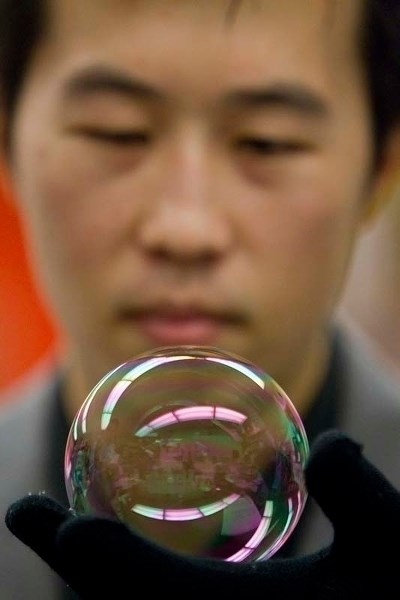As rain splattered on my windshield for the umpteenth time this month, I got to thinking: why are raindrops round? Why couldn't they be cubes or pyramids, or maybe tiny teddy bears? As with most things in science, the answer is simple yet complex. The answer starts with molecules, reports Mike Ng, a science teacher at Paul Kane with a penchant for silly science questions.
As rain splattered on my windshield for the umpteenth time this month, I got to thinking: why are raindrops round? Why couldn't they be cubes or pyramids, or maybe tiny teddy bears?
As with most things in science, the answer is simple yet complex.
The answer starts with molecules, reports Mike Ng, a science teacher at Paul Kane with a penchant for silly science questions.
“Water droplets involve two properties: cohesion and surface tension,” he explains.
Cohesion is the property of like molecules to stick together – a consequence of electrical attraction caused by the ways atoms are arranged. Water (H2O) has a distinct positive (the H or positive hydrogen atoms) and negative (the O or negative oxygen) pole to its molecules, making it super cohesive.
Pile a bunch of water molecules on top of each other, and they'll start attracting each other. Those in the middle of the pile will get pulled in all directions by their neighbours, so the forces cancel out.
But those on the outside are only pulled in one direction – towards the middle of the pile. This creates an energy imbalance called surface tension, one that the molecules try to minimize by minimizing the amount of exposed surface. That pulls them into the one shape that has the smallest area per volume: the sphere.
Pile up droplets, as Ng does with a pipette, and you'll see that they combine to form a bigger blob. The droplets cohere when they touch, at which point surface tension takes over to create a sphere. Pile up enough drops, and the weight of the water overcomes the surface tension and the blob collapses into a mess.
It's raining donuts?
You'll never see a perfectly round droplet unless you're in space, says Lorenz Sigurdson, a professor of fluid dynamics at the U of A who studies droplets. On Earth, gravity and atmospheric pressure almost immediately deform a falling droplet, giving it a blobby, flat-bottomed shape “sort of like a Boston crÈme donut.”
People think that droplets are tear-shaped based on observations of their faucets, he continues. Watch a drip on high-speed film (as he has), and you'll see that it starts as a column of water. Gravity pulls it down until it overcomes the surface tension, pulling off a blob of water with a pinched end and a teardrop shape.
Once it starts to fall, surface tension tries to pull the pointy end back in, squishing the drop like a pancake, Sigurdson says. But now it's too wide, so surface tension pulls the drop back in horizontally so it shoots out vertically. The drop flips back and forth between these two shapes until it loses enough kinetic energy to settle into its equilibrium state – the flat donut.
Surface tension is also what lets us blow bubbles, Ng notes. By adding soap to water, we can weaken the attractive force between its molecules and let them spread out more when we inject air.
“Huge amounts of surface tension are happening here,” he says, as he bounces a baseball-sized bubble on his hand.
The thin coat of water slowly drains from the top of the bubble to the bottom, refracting light and creating pretty rainbow colours, Sigurdson says. Once enough drains, the air pressure overcomes the surface tension and the bubble bursts, producing a plume of gas that resembles a mushroom cloud.
A droplet usually goes splat when it hits a surface due to momentum overcoming surface tension, Sigurdson says. If it hits water, it melds with it through cohesion, often sending out shockwaves as it does.
But if a drop hits the surface at just the right speed – as often happens in your coffee maker – it will trap air beneath it and skid around, hovercraft style.
“You'll actually see these beautiful little droplets speeding around,” Sigurdson says. Then, when the air dissolves, they'll vanish, and you'll wonder if they were ever there at all.
Who cares?
The shape of water drops is actually of critical importance to many fields of science.
Some of the earliest bits of chaos theory were developed to describe the maddeningly random patterns in dripping faucets that keep you up at night, Sigurdson says. DNA researchers need to know exactly how droplets hold their shape when they're positioning about 500,000 of them on a single microarray, and climate change modellers need to know how drops impact the ocean in order to determine the amount of CO2 they dissolve.
While you can make square bubbles, you're unlikely to see a square droplet unless you've got some sort of massive electromagnetic field, says Daniel Alessi, the Encana chair in water resources at the U of A.
“The interaction between the water molecules is actually pretty strong.”
So, no bear drops. I'm fine with it raining donuts, though.
Scientific St. Albert
Like science? So do we! Starting today, the Gazette will examine a simple, common phenomenon in the St. Albert region and explain it with the help of local scientists every other week.
Got a burning scientific question? Send it in to [email protected].




